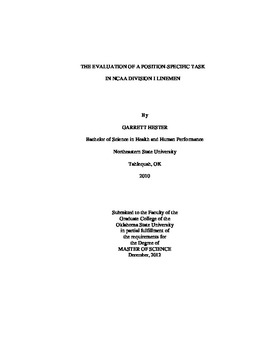| dc.contributor.advisor | Jacobson, Bert H. | |
| dc.contributor.author | Hester, Garrett | |
| dc.date.accessioned | 2014-04-16T03:11:35Z | |
| dc.date.available | 2014-04-16T03:11:35Z | |
| dc.date.issued | 2012-12-01 | |
| dc.identifier.uri | https://hdl.handle.net/11244/9753 | |
| dc.description.abstract | It is the responsibility of the strength and conditioning professional to implement quality training programs and properly evaluate each athlete's physical performance. It is essential that strength and conditioning professionals have access to an evaluative tool that provides a practical, position-specific assessment of playing ability in collegiate linemen. The purpose of this study was two-fold: To compare the performance of a position-specific task on the MAXX Football Sled Device (MFSD) between NCAA Division I offensive and defensive linemen. Also, to investigate any associations among selected strength and power variables with performance on the MFSD in NCAA Division I offensive and defensive linemen. Twenty-six NCAA Division I offensive (n=12) and defensive linemen (n=14) (age 20.11 1.49yrs) performed ten "fire-and-drive" repetitions on the MFSD. Upon an auditory signal rendered from the MFSD, subjects exploded in to the breast plate region of the dummy as forcefully and rapidly as possible. After each repetition subjects reset themselves in a three point stance. Timing between repetitions was an automatically randomized duration of 6 to 10 sec. The MFSD measured average force (AVGF) across the ten trials and movement time (MT), the time from the auditory signal to initial contact on the dummy, for each of the ten repetitions. Secondary data including 1 RM of the squat, bench press, and power clean, along with vertical jump, 10 yd. sprint, 40 yd. sprint, and body fat percentage were gathered from the team's strength and conditioning staff. Defensive linemen were found to produce significantly lower movement times when compared to offensive linemen (p = 0.032). There were no significant relationships found between the dependent variables gathered from the MFSD and any independent variables. Test-retest reliability demonstrated strong reliability with the device for both AVGF (ICC = .813; SEM = 93.4) and MT (ICC = .828; SEM = .022). Results of this study indicate that defensive linemen accelerate out of the three point stance quicker than offensive linemen. Further exploration for the purpose of finding exercises that correlate with a position-specific task in these athletes is warranted. | |
| dc.format | application/pdf | |
| dc.language | en_US | |
| dc.publisher | Oklahoma State University | |
| dc.rights | Copyright is held by the author who has granted the Oklahoma State University Library the non-exclusive right to share this material in its institutional repository. Contact Digital Library Services at lib-dls@okstate.edu or 405-744-9161 for the permission policy on the use, reproduction or distribution of this material. | |
| dc.title | Evaluation of a Position-specific Task in Ncaa Division I Linemen | |
| dc.type | text | |
| dc.contributor.committeeMember | Smith, Doug B. | |
| dc.contributor.committeeMember | O'Brien, Matthew S. | |
| osu.filename | Hester_okstate_0664M_12521.pdf | |
| osu.college | Education | |
| osu.accesstype | Open Access | |
| dc.description.department | School of Teaching and Curriculum Leadership | |
| dc.type.genre | Thesis | |
| dc.subject.keywords | college | |
| dc.subject.keywords | football | |
| dc.subject.keywords | linemen | |
| dc.subject.keywords | movement time | |
